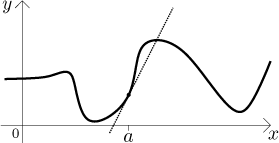
In the previous section we talked about approximating functions by tangent lines. While this is certainly useful, there is a little problem. Consider the following picture.

While the tangent line approximates the function nicely close to a, the error quickly grows when we move a bit away. The reason for this is obvious, the function curves while the tangent line does not. We would definitely get better results if we tried to approximate by some function that also curves. The second simplest function (after a straight line) is a quadratic polynomial that gives parabolas. Indeed, it seems in the picture that we would do much better with a parabola:
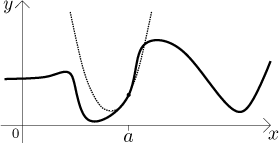
How do we find the best fitting parabola? We have to look closer at the requirements for the tangent line. There we had two. First, the tangent line had to go through the given point. Second, it had to "hug" the curve, in other words, it had to have the same direction as the function at the point a. Thus we actually wanted that the tangent line and the function have the same value and derivative at a. We then obtained the formula for the tangent line, we rearrange it a bit to fit better our purpose.
![]()
To get the best fitting parabola we obviously keep these two requirements and add another one, it makes sense to ask that the parabola also curves the same way as f at a, that is, now we also want equality of the second derivative. A little analysis shows that the parabola that satisfies these three requirements is given by the formula
![]()
Parabola approximated better, but it is obvious from the picture that a cubic curve could do even better and we do not complicate things much, polynomials are easiest functions to work with.
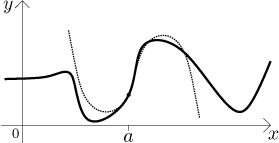
The best fitting cubic curve satisfies the same conditions as the parabola but also has the same third derivative at a as f, it is given by
![]()
Most of the pattern is now clear. Of course, there is no reason to stop at degree three, polynomials are wonderful functions and we can try increasing the degree of the approximating polynomial until we are satisfied.
Definition.
Let a function f has all derivatives up to order n at a. Then we define the Taylor polynomial of f of degree n with center a as
Note that the first two terms also conform to the pattern with derivative and
factorials that we have in the sum, for instance
Theorem.
Let a function f has all derivatives up to order n at a, let T be the Taylor polynomial of f of degree n with center a. Then T satisfies
T(a) = f (a), T ′(a) = f ′(a), T ′′(a) = f ′′(a), . . . ,T (n)(a) = f (n)(a), and it is the only polynomial of degree at most n with this property.
Assume that we want to approximate a function f by a polynomial
p (for some possible reasons for it see
below). As we saw above, the
conditions
Example: Consider the function
![]() .
.
Solution: To create T2 we need the first two derivatives of f, then we need to substitute a into them.

Now we create the Taylor polynomial.
![]()
It remains to estimate the root of 5.
![]()
Note that we did not multiply out the Taylor polynomial above. It is traditional to keep the Taylor polynomial in this way, since then we can see what is the reference point a for the Taylor polynomial. Note that a does not appear in the notation anywhere else. Some authors do not like this and use the notation Ta,n. We chose to follow the other convention, since it is easier and as we saw, the center is obvious from the polynomial if we keep it in the proper way.
There is another reason for keeping the terms
Definition.
Let a function f has all derivatives up to order n at a. Consider the Taylor polynomial T of a function f of degree n with center a. We define the remainder as
Rn(x) = f (x) − Tn(x).
We have a theorem that specifies this remainder. The formulation will be a bit unusual, since in general we do not know whether x is less then or greater than a.
Theorem (Taylor's theorem).
Consider two distinct real numbers a and x. Let I be the closed interval with these two points as endpoints. Assume that a function f has continuous derivatives up to order n on I and f (n+1) on the interior Int( I ). Then
Moreover, there exists a number c between a and x such that
The first result is called the integral form of the remainder, the second is called the Lagrange form of remainder. In fact, these precise results are also not exactly useful, since the integral may easily be too difficult to evaluate, while the second statement is existential, we know that such a c exists, but we have no idea what it is. However, the Lagrange form can be approximated from above and with a bit of luck it turns out that the upper estimate is small. We will return to the example above.
Example: Estimate the error we made in estimating the root of 5 above.
Solution:
We used T2 to approximate, so we need to estimate
![]()
When estimating
![]()
The estimate we used above is used quite often, in general we have
![]()
For many nice functions this maximum does not grow too fast, so when divided
by factorial, it goes to zero as
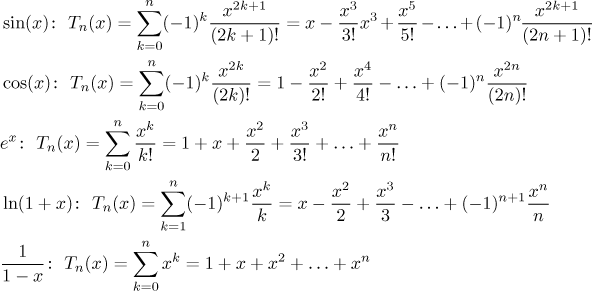
As these polynomials show, we most often take

To give you some idea how this works we will now show the first few Taylor polynomials for sine and cosine. Note that polynomials for the sine do not feature even powers. This is no accident, odd functions always have Taylor polynomials with just odd powers. Thus in particular T2 is the same as T1, T4 is the same as T3, etc., so we need not draw Taylor polynomials of even degree. Similarly we will only draw polynomials of even degrees for cosine. Note how by increasing the degree we enlarge the set where the approximation is quite good.
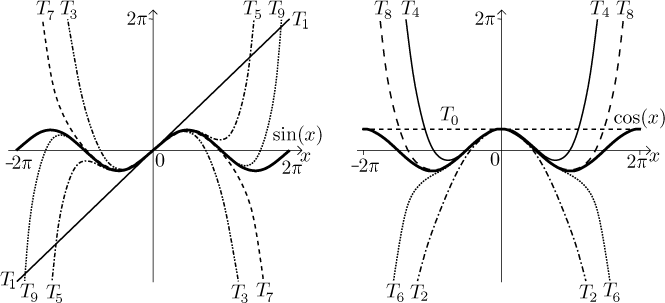
We get a good approximation for even very large parts of sine and cosine by
taking Taylor polynomials of large enough degrees. It works similarly
for the exponential.
However, it would be a mistake to believe that this is some rule and one
can rely on it. In the next picture we show the first few polynomials for
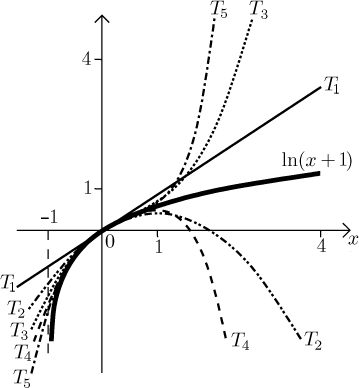
Here the quality of approximation seems to improve on the interval
For a brief overview and a few more examples see Taylor polynomial in Methods Survey - Applications, examples are also in Solved Problems - Applications.
To round up our exposition we will state formally the property of even/odd functions that we hinted on above.
Fact.
Let f be a function that has Taylor polynomial of degree n with center ata = 0, let ak be its coefficients.
If f is odd, thenak = 0 for all even k.
If f is even, thenak = 0 for all odd k.
Why do we talk about approximations? Functions with more complicated formulas can be difficult to handle and often it is possible to approximate them by something nicer under controlled conditions. Thus one can sometimes replace functions by their approximating polynomials for instance in limits or in integrals. While Taylor polynomials are definitely important in theoretical considerations, perhaps the most obvious need is when it comes to actual evaluation.
Operations that we (humans) can do are limited to addition, subtraction,
multiplication and division. How do we know then what is, say,
The rise of programmable computers (e.g. calculators) hid this from a casual user, but in fact the problem remains the same, since a computer's processor can only do the same algebraic operations as human computer's brain. When we press the button labeled "ln" on a calculator, a lot of things happen, namely the calculator quickly evaluates an approximating algorithm. While Taylor polynomials are a good start, they tend to require many operations. This is unpleasant, and was more so in the days of human computers. A lot of research went into the ways of the "fastest" (in the sense "requiring the least number of operations") approximations and the results came handy when people started designing calculators.
We conclude this section with the following observation. Consider a function
f that has all derivatives everywhere, fix a point a. Now we
can create Taylor polynomials with this center of every degree. Assume that
the function is "nice" in the sense that for every x the remainder
goes to zero as we just discussed. This means that for every x we can
approximate